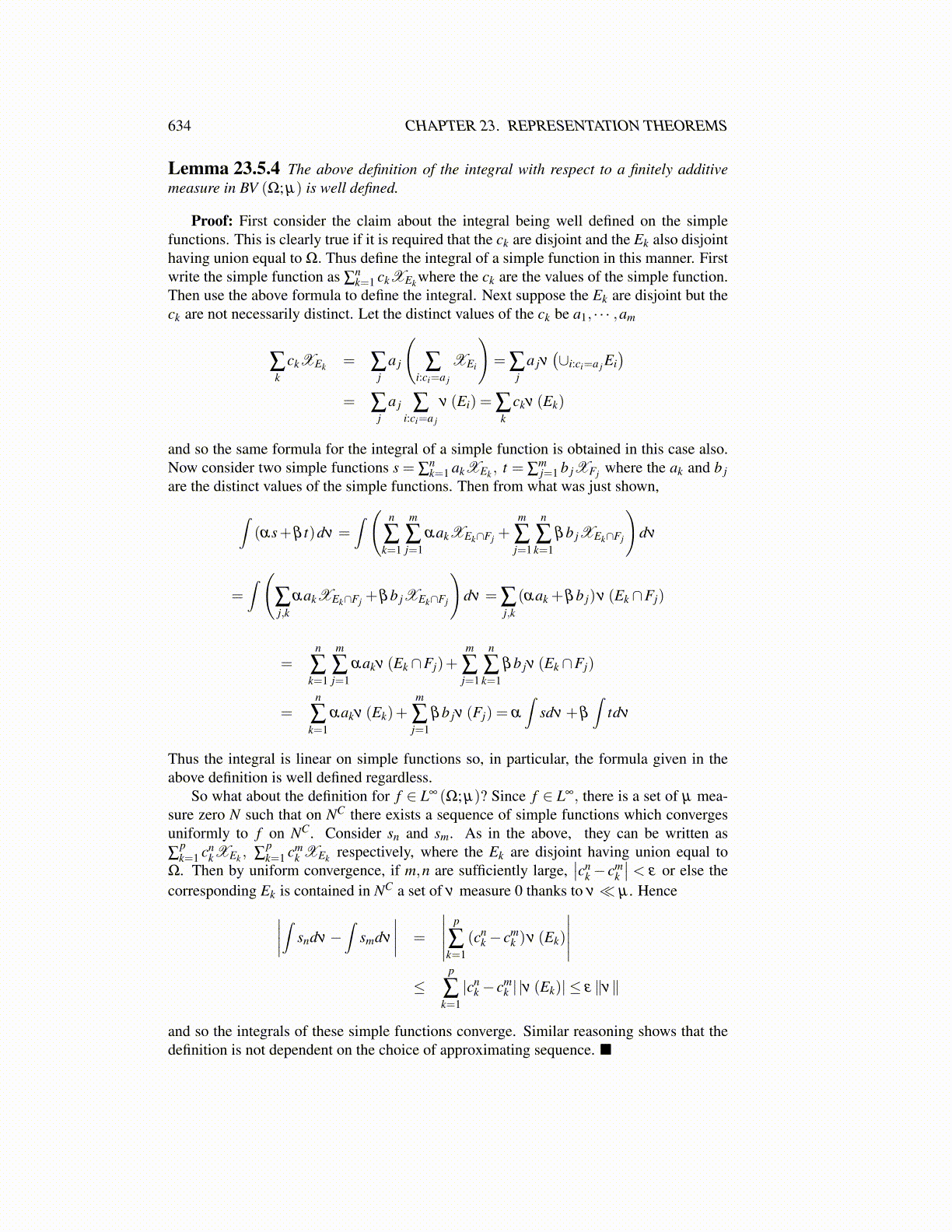
634 CHAPTER 23. REPRESENTATION THEOREMS
Lemma 23.5.4 The above definition of the integral with respect to a finitely additivemeasure in BV (Ω; µ) is well defined.
Proof: First consider the claim about the integral being well defined on the simplefunctions. This is clearly true if it is required that the ck are disjoint and the Ek also disjointhaving union equal to Ω. Thus define the integral of a simple function in this manner. Firstwrite the simple function as ∑
nk=1 ckXEk where the ck are the values of the simple function.
Then use the above formula to define the integral. Next suppose the Ek are disjoint but theck are not necessarily distinct. Let the distinct values of the ck be a1, · · · ,am
∑k
ckXEk = ∑j
a j
(∑
i:ci=a j
XEi
)= ∑
ja jν
(∪i:ci=a j Ei
)= ∑
ja j ∑
i:ci=a j
ν (Ei) = ∑k
ckν (Ek)
and so the same formula for the integral of a simple function is obtained in this case also.Now consider two simple functions s = ∑
nk=1 akXEk , t = ∑
mj=1 b jXFj where the ak and b j
are the distinct values of the simple functions. Then from what was just shown,
∫(αs+β t)dν =
∫ ( n
∑k=1
m
∑j=1
αakXEk∩Fj +m
∑j=1
n
∑k=1
βb jXEk∩Fj
)dν
=∫ (
∑j,k
αakXEk∩Fj +βb jXEk∩Fj
)dν = ∑
j,k(αak +βb j)ν (Ek ∩Fj)
=n
∑k=1
m
∑j=1
αakν (Ek ∩Fj)+m
∑j=1
n
∑k=1
βb jν (Ek ∩Fj)
=n
∑k=1
αakν (Ek)+m
∑j=1
βb jν (Fj) = α
∫sdν +β
∫tdν
Thus the integral is linear on simple functions so, in particular, the formula given in theabove definition is well defined regardless.
So what about the definition for f ∈ L∞ (Ω; µ)? Since f ∈ L∞, there is a set of µ mea-sure zero N such that on NC there exists a sequence of simple functions which convergesuniformly to f on NC. Consider sn and sm. As in the above, they can be written as∑
pk=1 cn
kXEk , ∑pk=1 cm
k XEk respectively, where the Ek are disjoint having union equal toΩ. Then by uniform convergence, if m,n are sufficiently large,
∣∣cnk− cm
k
∣∣ < ε or else thecorresponding Ek is contained in NC a set of ν measure 0 thanks to ν ≪ µ . Hence∣∣∣∣∫ sndν−
∫smdν
∣∣∣∣ =
∣∣∣∣∣ p
∑k=1
(cnk− cm
k )ν (Ek)
∣∣∣∣∣≤
p
∑k=1|cn
k− cmk | |ν (Ek)| ≤ ε ∥ν∥
and so the integrals of these simple functions converge. Similar reasoning shows that thedefinition is not dependent on the choice of approximating sequence. ■